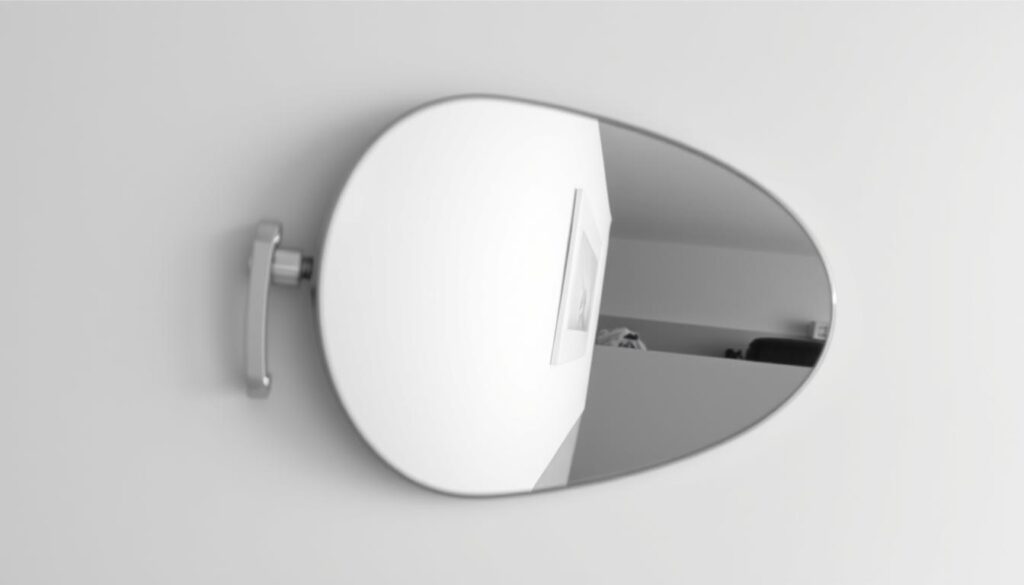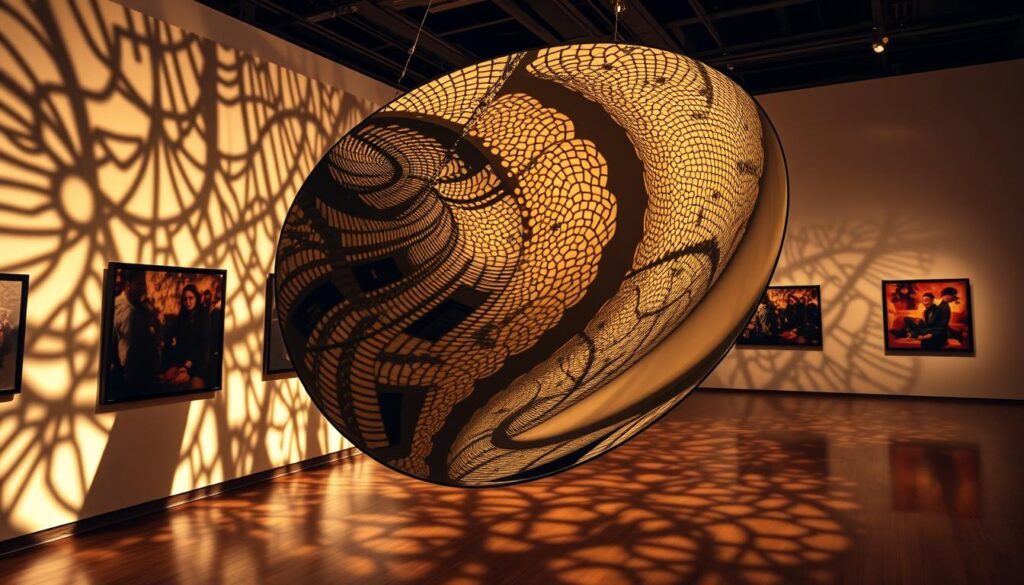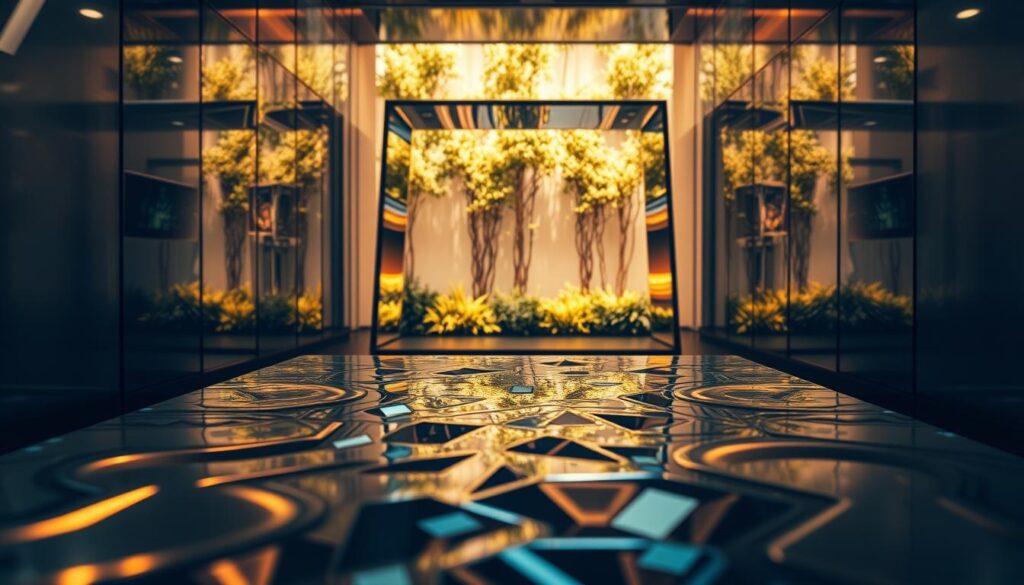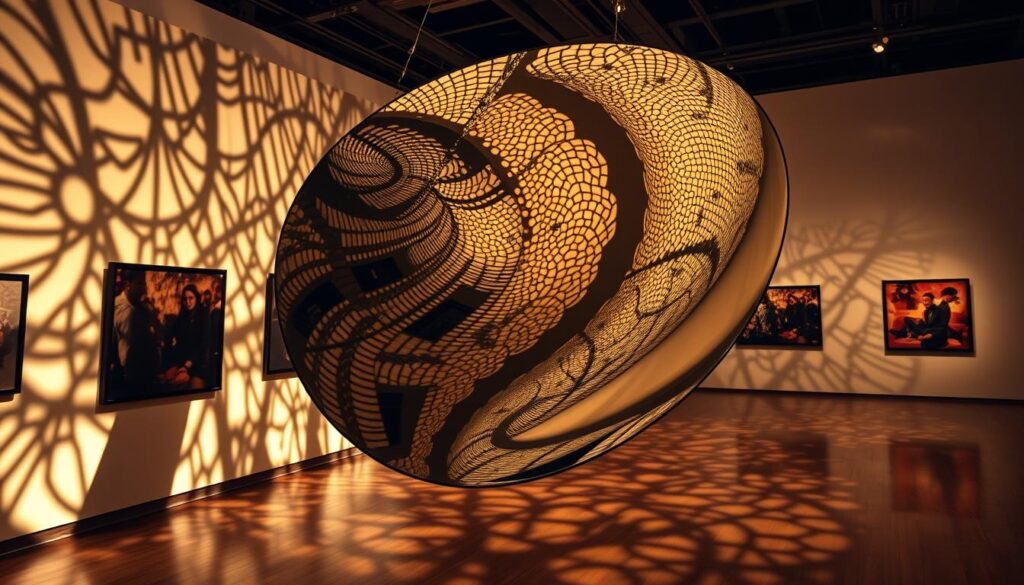Captivating Mirror with a Delayed Reflection, The mirror with delayed reflection is a new optical illusion that plays with your mind. It uses advanced technology to make time and space seem different. This creates a fascinating experience.
Imagine a mirror that shows your image but with a twist. It reflects you but with a delay, making it an optical illusion. This is thanks to advanced technology that plays with time and space. It’s so real, it makes you wonder how it works.

Introduction to Delayed Reflection
This mirror combines time delay and reflection technology for a unique effect. It changes how you see time and space. This shows how technology can create amazing illusions like this.
Key Takeaways Captivating Mirror with a Delayed Reflection
- The mirror with delayed reflection uses advanced reflection technology and time delay to create a mind-bending experience.
- The optical illusion created by the mirror is realistic and can leave users spellbound.
- The mirror manipulates the user’s perception of time and space, creating a unique experience.
- Time delay and reflection technology work together to create the optical illusion.
- The mirror’s effect is a great example of innovative use of time delay and reflection technology.
- The mirror’s technology can create a fascinating optical illusion that can be used in various applications.
Understanding the Mirror with Delayed Reflection Phenomenon
The idea of temporal displacement is key to grasping how mirrors with delayed reflection work. These mirrors, known as delayed reflection mirrors, create an optical illusion. They delay the reflection by a few seconds.
This magic happens thanks to advanced mirror technology and time delay systems. Together, they produce a mesmerizing effect.
At the core of this technology are the mirror, the time delay mechanism, and display technology. These parts work together to create the illusion. Let’s explore how they do it.
Basic Principles of Delayed Reflection
Delayed reflection uses advanced tech to create a time gap between the real and projected reflections. This gap makes an illusion that’s both fascinating and intriguing. Mirrors used here go beyond the usual, incorporating advanced display tech.
How Time Delay Creates the Illusion
The time delay mechanism is vital in delayed reflection mirrors. It introduces a gap between the real and projected reflections. This gap creates an optical illusion that’s mesmerizing.
The delay can be tweaked to change the effect. This makes the experience even more captivating.
Components of a Delayed Reflection System
A delayed reflection system has three main parts: the mirror, the time delay mechanism, and display technology. These components work together to create the illusion of temporal displacement. This makes using delayed reflection mirrors a unique and captivating experience.
Understanding how these components interact shows the complexity and beauty of this technology.
The Science Behind Time-Delayed Mirrors
Time-delayed mirrors work by playing with light and its reflection. They use optical effects to make it seem like light is reflected later than it really is. This magic happens thanks to mirror technology and how light interacts with the mirror.
These mirrors use illusion mirrors to trick our eyes. They’re designed to make light seem to bounce back at a slower pace. This is done by changing the light’s path, making it seem like it’s delayed. Optical effects like refraction and reflection help make this illusion real.
- The use of advanced mirror technology to create the illusion of delayed reflection
- The manipulation of light and its interaction with the mirror’s surface to create optical effects
- The integration of illusion mirrors to create a realistic and convincing delayed reflection effect
Learning about time-delayed mirrors shows us how advanced this technology is. It combines optical effects and mirror technology to create something truly amazing. This technology has amazed and inspired people everywhere.
How Digital Processing Creates the Delay Effect
The delay effect in reflection mirrors comes from digital processing. This tech uses cameras and sensors to capture your image. Then, a processing unit adds a time delay, making it an optical illusion.
Digital processing lets us create many effects, from simple delays to complex illusions. Advanced camera and sensor tech are key. They capture high-quality images for processing.
Camera and Sensor Technology
The tech in these mirrors is top-notch. It captures images well and sends them to the processing unit. This is crucial for the delay effect, as it captures images in real-time.
Processing Units and Timing Mechanisms
The processing unit is the mirror’s brain. It adds the time delay and creates the illusion. It uses smart algorithms and timing to make the delay smooth and realistic.
Display Technologies Used
The display tech in mirrors is also vital. It projects the delayed reflection, making the experience immersive. Advanced displays like LED and OLED ensure clear, vibrant images.
- Camera and sensor technology
- Processing units and timing mechanisms
- Display technologies
In summary, digital processing tech creates the delay effect in mirrors. It uses cameras, sensors, processing units, and displays. These technologies allow for a variety of effects, from simple delays to complex illusions.
Applications in Modern Technology
The uses of mirrors with delayed reflection are endless. In entertainment, delayed reflection mirrors can make experiences more interactive and immersive. Theme parks and museums can use them to create engaging exhibits.
These mirrors also have a place in education and advertising. Teachers can use them to teach about time and space in a fun way. Advertisers can make ads that grab people’s attention.
Some possible uses for delayed reflection mirrors include:
- Interactive exhibits in museums and theme parks
- Immersive experiences in entertainment venues
- Interactive lessons in educational settings
- Engaging ads in advertising campaigns
The possibilities for mirrors with delayed reflection are endless. As reflection technology grows, we’ll see new uses in many areas.
Psychological Impact of Delayed Reflections
Delayed reflections can deeply affect our mind. When we see temporal displacement in illusion mirrors, our brain struggles to understand the delay. This can make us feel disconnected from our body and mind.
Our view of reality changes with optical effects that make reflections seem delayed. Trying to make sense of this difference affects our self-awareness and identity.
Perception and Reality
The connection between what we see and reality is tricky. Delayed reflections make this connection even more complex. By using optical effects and creating illusion mirrors, we can feel time and space differently.
Brain Response to Temporal Displacement
Studies show our brain tries to bridge the gap between our actions and their reflection. This can cause various psychological effects, from slight confusion to deep changes in how we see ourselves.
Effects on Self-Awareness
Delayed reflections can deeply impact how we see ourselves. By experiencing temporal displacement and playing with optical effects, we learn more about our perception and reality. This can boost our self-awareness and help us appreciate the intricate bond between our body and mind.
Creative Uses in Art and Entertainment
Mirror technology is now used in art and entertainment to make experiences more interactive and immersive. Reflection mirrors with time delay are popular among artists and performers. They use the time delay to create innovative pieces that make viewers think differently about reality.
Artists use mirror technology in interactive installations that react to the viewer’s movements. This creates a sense of engagement and participation. The time delay feature also helps create illusionary effects, making it seem like the viewer is interacting with a virtual version of themselves. This technology is used in theater, dance, and visual arts.
The possibilities for mirror technology in art and entertainment are endless. Here are a few examples:
- Creating immersive experiences in museums and galleries
- Developing interactive performances that incorporate time delay and reflection
- Designing innovative sets and props for film and theater productions

As the technology improves, we’ll see even more creative uses in art and entertainment. The ability to play with time delay and reflection will let artists and performers create unique experiences. They’ll be able to push their craft to new heights and engage their audiences in new ways.
Installation and Setup Requirements
Setting up a mirror with delayed reflection needs careful thought. The mirror’s size, weight, and power needs are key. These details affect how well the illusion works.
Think about the space around the mirror too. The size of the mirror and where it goes matter a lot. A big mirror needs more room for a full effect, while a small one fits better in tight spots. These mirrors are great for creating cool optical illusions.
- Technical specifications: size, weight, and power requirements
- Space considerations: amount of space required and surrounding environment
- Maintenance guidelines: regular cleaning and upkeep to ensure optimal performance
By paying attention to these points, you can make a mirror with delayed reflection that’s truly amazing.
Benefits and Practical Applications
The mirror with delayed reflection brings many benefits and uses, thanks to its reflection technology. It creates a delayed reflection, making it great for interactive and immersive experiences. These are useful in education and entertainment.
This technology is also great for creating innovative art. It uses temporal displacement to play with our view of time and space. The optical effects it produces can make stunning visual displays. This makes it a favorite among artists and designers.

The mirror with delayed reflection has many exciting uses. Some examples include:
- Interactive exhibits in museums and galleries
- Immersive experiences in theme parks and entertainment venues
- Innovative advertising and marketing campaigns
In summary, this mirror has the power to change how we see technology and art. It offers a unique and captivating experience that challenges our views and sparks our imagination.
Common Misconceptions About Delayed Reflection Mirrors
Many people think illusion mirrors are too complicated or too pricey. But, learning about mirror technology and what it can do helps clear up these myths.
Some folks believe reflection mirrors are hard to install and keep up. But, they’re actually simple to put in and need little upkeep. Here are some common misconceptions about delayed reflection mirrors:
- They are too expensive: While top-notch illusion mirrors might cost more, there are cheaper choices out there.
- They are difficult to install: With the right tools and instructions, setting up a mirror technology system is easy.
- They require a lot of maintenance: Reflection mirrors are made to be easy to care for and can be quickly cleaned and updated.
Knowing the truth about illusion mirrors, mirror technology, and reflection mirrors shows their real value. Their ability to create a delayed reflection is truly captivating and inspiring.
Future Developments in Delayed Mirror Technology
The future of delayed mirror technology looks bright. We can expect big steps in time delay and optical illusion areas. Researchers are working hard to improve how we use light and reflection.
New things might include artificial intelligence and virtual reality with delayed mirrors. This could lead to cool things like virtual try-on and interactive exhibits. Using mirrors in these ways could make experiences more real and fun.
Some key areas to watch for include:
- Improving the accuracy and consistency of time delay effects
- Enhancing the realism and depth of optical illusion capabilities
- Exploring new materials and technologies for creating mirrors with unique properties
As delayed mirror technology grows, we’ll see it used in many new ways. It could change entertainment, education, marketing, and more. With its power to create immersive experiences, it’s definitely something to keep an eye on.
The captivating mirror with a delayed reflection challenges our perception of reality, making us question what we see. Similarly, the mysterious box that cannot be opened teases our curiosity, hiding secrets that may never be revealed.
Conclusion: Embracing the Magic of Temporal Reflection
Exploring delayed reflection mirrors shows us a new way to see ourselves. This technology creates images that appear after a delay. It changes how we see reality and opens up new ways to create and use mirrors.
The science behind reflection technology and its effects on our minds are fascinating. It can change how we see ourselves and the world. As this technology grows, we’ll see even more amazing ways to mix reality and illusion.
If you love tech, art, or just cool mirror tricks, check out delayed reflection mirrors. They offer a unique way to see the world. Dive into the magic of temporal reflection and discover something truly special.
FAQ
What is the basic principle behind the mirror with delayed reflection?
The mirror with delayed reflection works by delaying the reflection by a few seconds. This creates an optical illusion that is mesmerizing.
How does digital processing create the delay effect?
Digital processing technology is used to create the delay. The camera captures the image and sends it to a processing unit. There, the delay is applied to create the effect.
What are the potential applications of the mirror with delayed reflection?
This mirror has many uses in modern tech. It can be used in entertainment, education, and advertising. It makes experiences more interactive and immersive.
What is the psychological impact of delayed reflections?
The mirror can deeply affect the user’s mind. It creates a sense of time displacement, changing how we see reality. This can profoundly impact our self-awareness.
What are the common misconceptions about delayed reflection mirrors?
Many think the mirror is too complex or too pricey. But, these myths can be cleared up by explaining how it works and its value.
What are the future developments in delayed mirror technology?
The future of delayed mirror tech is bright. New tech and advancements will bring even more exciting experiences. It will likely include AI and virtual reality.
Table of Contents
Source link
- https://en.wikipedia.org/wiki/Magic_Mirror_%28M._C._Escher%29
- https://www.reddit.com/r/nosleep/comments/bm0zao/the_reflection_in_my_mirror_is_delayed/
- https://www.youtube.com/watch?v=xEHKuOlpanQ
- https://www.tiktok.com/discover/delayed-reflection-in-mirror
- https://physics.stackexchange.com/questions/649738/does-real-life-have-update-lag-for-mirrors
